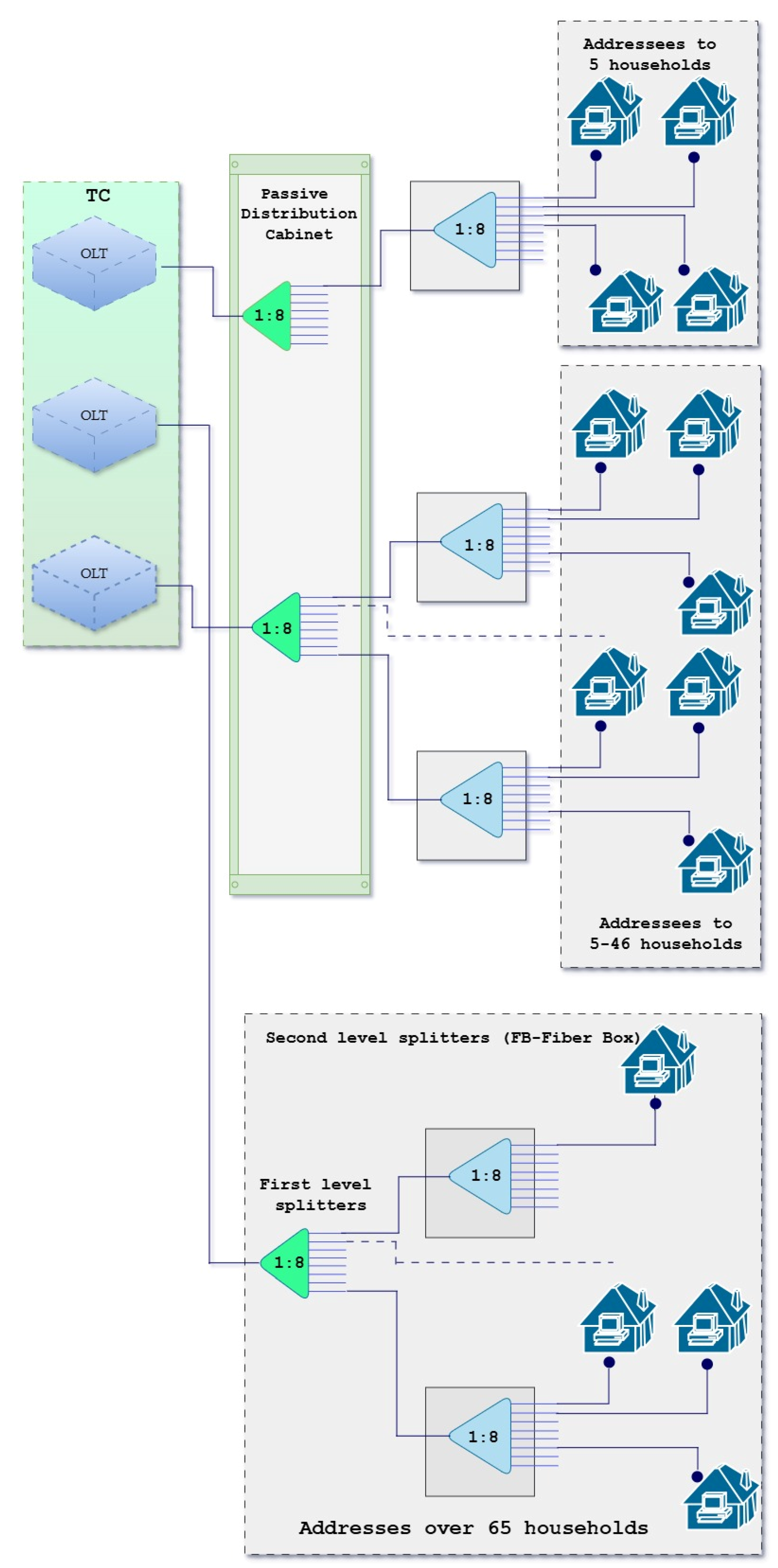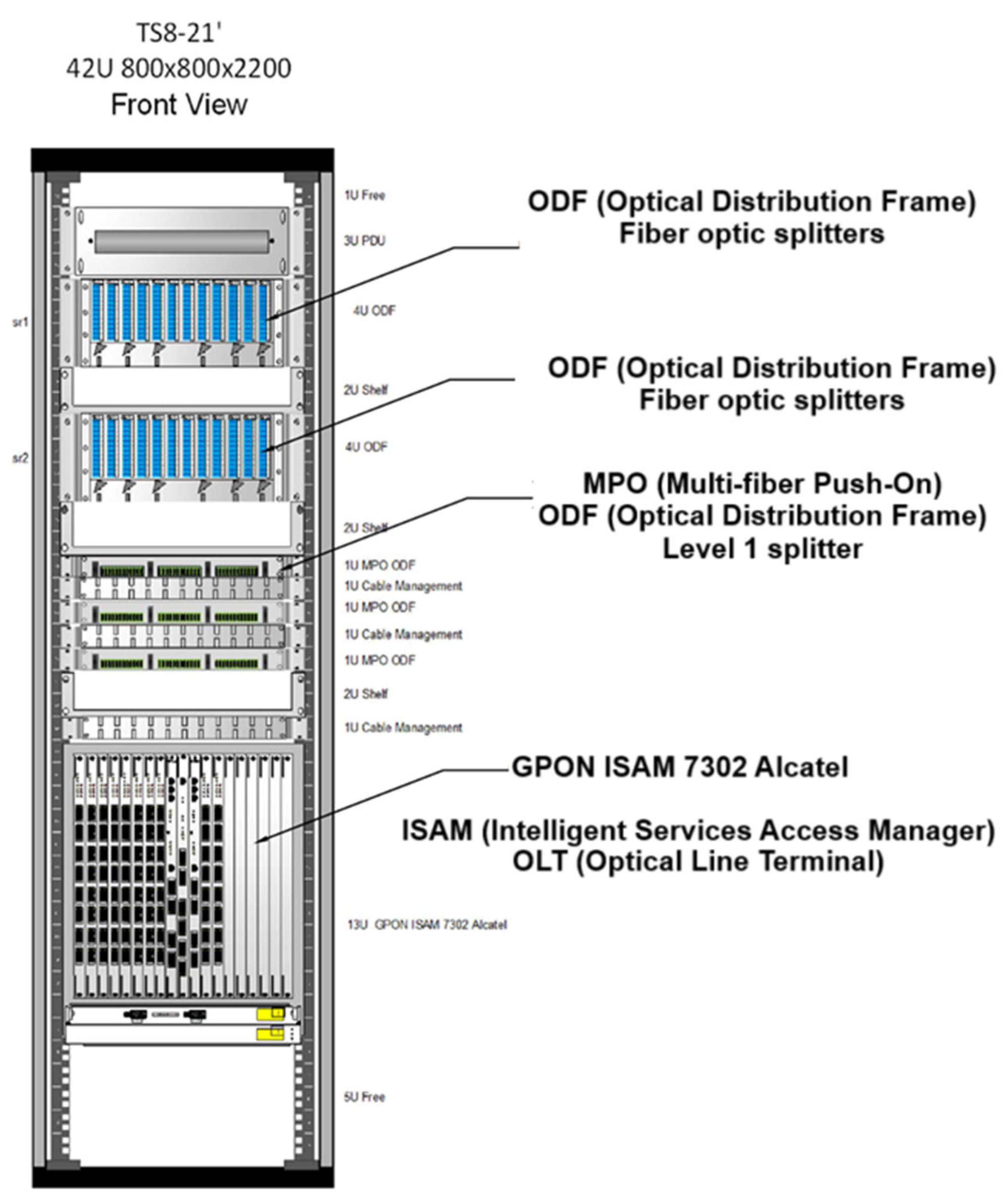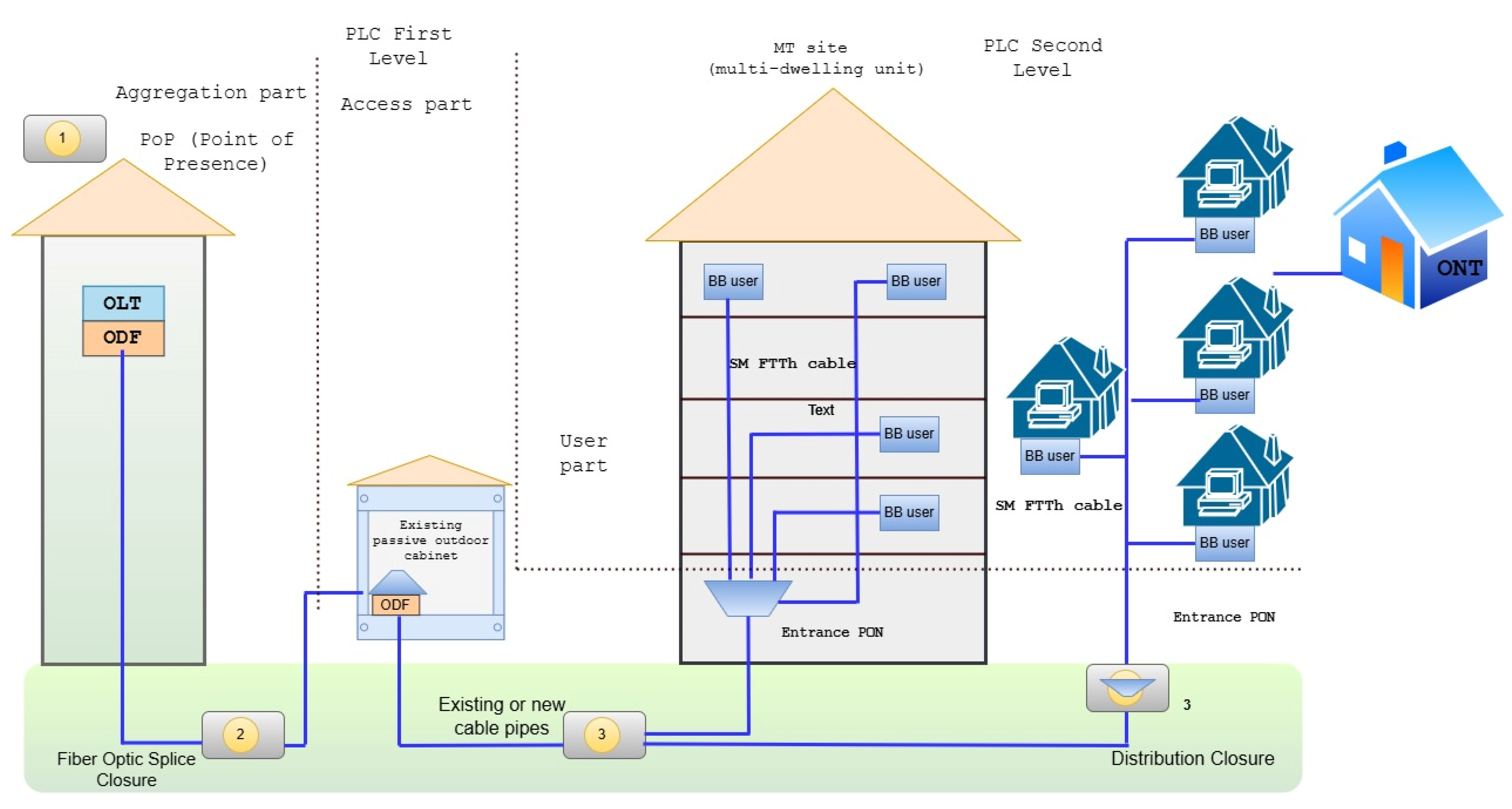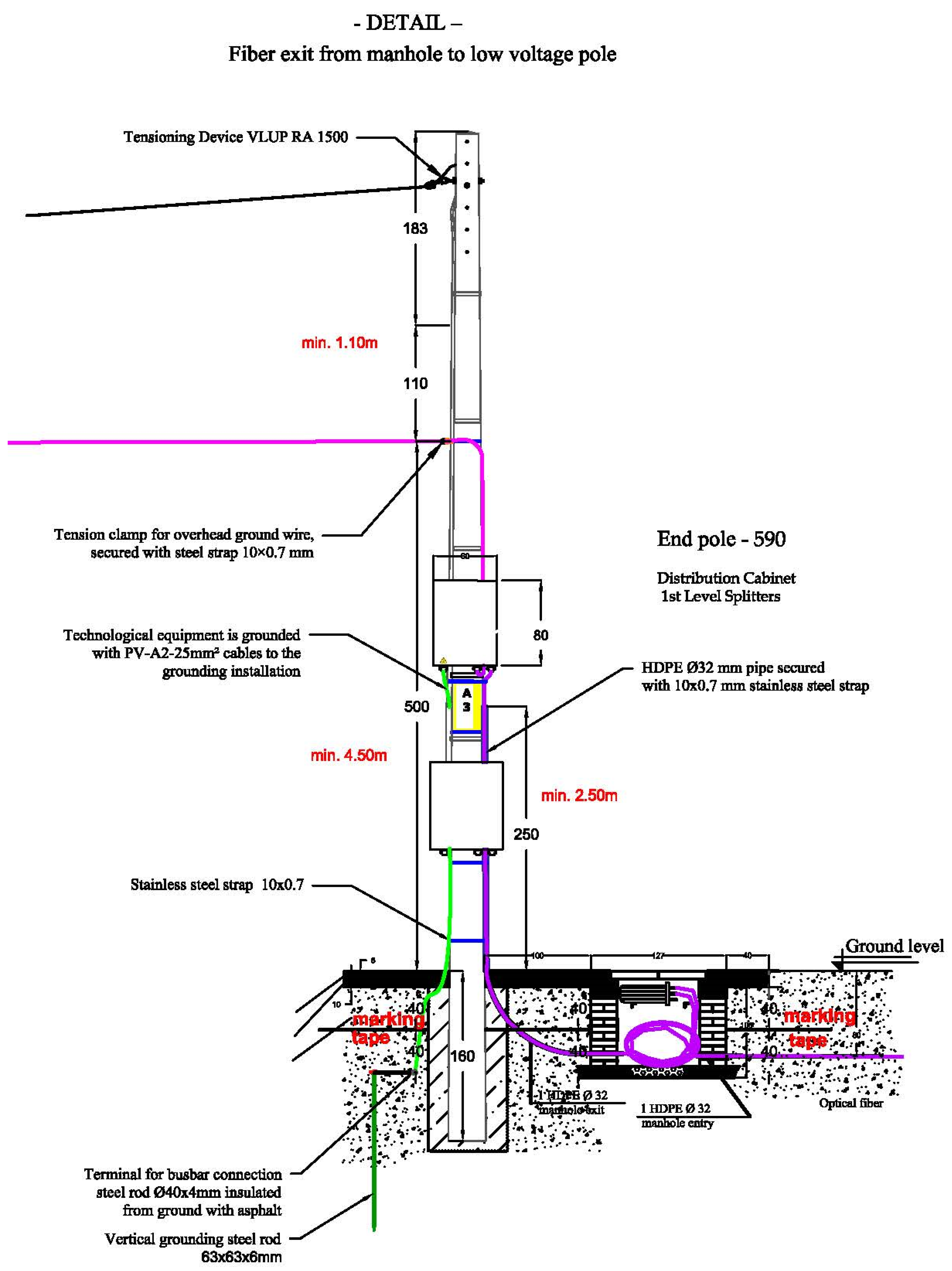Design and Implementation of a Passive Optical Network for a Small Town †
Abstract
1. Introduction
2. Technologies
3. Methodology
3.1. Service Requirements and Bandwidth Estimation
3.2. Traffic Aggregation and PON Dimensioning
3.3. Topology Selection (Point-to-Multipoint Tree)
3.4. Splitter Configuration and Optical Budget Considerations
4. Results
- Based on the number of households, the branching scheme is first determined.
- All second-level splitters with a division ratio of 1:8 are connected to the outputs of first-level 1:8 splitters located in inspection shafts or a technological room.
- The number of first-level splitters determines the number of fibers that will be needed in the connecting cable to the technological room where the OLT is located.
- First-level splitters are placed in an existing street cabinet or in the technological building itself, when it is serviced immediately around it.
- The number of first-level splitters determines the number of OLT SFPs that will be needed in the local central office.
- The number of OLT cards is determined based on the number of OLT SFPs.
- The number of OLT frames and their type is determined based on the final expected number of cards.
- The PON box and the GCO socket can be installed simultaneously.
- The placement of the splitters in the box and the installation of the adapters can be completed in advance.
- Before connecting, the MPO connectors are cleaned with a specialized tool.
- The GCO socket is installed in a closed car to avoid contamination.
- All connectors and splitters are numbered according to the fault discovery protocol.
- It is not allowed to leave a technological reserve of cable larger than that required for hanging the box in the volume of the cabinet. In case of excess cable, it is re-drawn and formed at the GCO.
- All openings in the cabinet to the shaft are sealed to prevent the penetration of humid air from the shaft and its condensation in the cabinet.
- Each PON box is permanently labeled with the designations specified in the FDP on the outer and inner sides of the lid.
- Before closing the boxes, the correct formation and placement of the optical fibers is checked according to the instructions in order to avoid damage when closing it.
- Protective caps are placed on all connectors (adapters) that are not connected.
- Each box serves as a terminal element for FTTH connection cables containing 4/12 OF, which are terminated directly in the PON-ES (passive optical network equipment splice).
- The splitters used, the connection method, and the activated fibers are implemented in accordance with the established standards for passive optical networks (PON) [11].
- A single distribution splice connects up to 4–5 building entrances, and is installed according to the optimized route layout.
- The connection boxes (PON-ES) are installed in the common area of the building, while complying with the requirements for operational maintenance and long-term reliability.
- Fibers are connected to the second level splitter located in the PON-ES module via preinstalled LC/APC connectors (LC—lucent connector, APC—angled physical contact), which ensure quick installation and stable optical connections.
- The drop cable must allow easy separation of the power element and the optical cable element to facilitate handling during installation. An example of an aerial optical cable connection between buildings is presented in Figure 5.
- The connecting subscriber cable is installed with a suspension element on the pole and on the house, according to the suspension requirements, and the maximum distance between the support points should not exceed 20 m.
- After removing the carrier element from the cable, an SC/APC field-mount connector is installed on site, which provides an optical connection to the ONU subscriber unit;
- Connection cables connect to free optical ports of the PLC splitters located in the connection sleeves or to fibers coming from adjacent sleeves with splitters.
- Installation of fiber optic connectors is completed on an existing pole with a metal band and plate from the connector kit.
- The plank is placed parallel to the roadway, if possible, on the side of the pedestrian strip 20 cm below the point of suspension of the optical cable.
- There are two reserves of cable for aerial installation, including one to use when the socket can be disassembled from the ladder and the fibers are to be welded in a workspace next to the ladder (400 cm) and one to install inside the socket (150 cm).
- The configuration and placement of the cable is carried out according to the geometric requirements specified in Figure 6, and it is not allowed to leave a spare cable longer than 5 m on each side.
- The permissible reserve for future installation of the socket without interruption of the cable must be up to 13 m, measured from the point of suspension of the cable.
5. Conclusions
Author Contributions
Funding
Institutional Review Board Statement
Informed Consent Statement
Data Availability Statement
Acknowledgments
Conflicts of Interest
References
- Mendonça, S.; Damásio, B.; Charlita de Freitas, L.; Oliveira, L.; Cichy, M.; Nicita, A. The rise of 5G technologies and systems: A quantitative analysis of knowledge production. Telecommun. Policy 2022, 46, 102327. [Google Scholar] [CrossRef]
- Shafi, M.; Molisch, A.; Smith, P.; Haustein, T.; Zhu, P.; De Silva, P.; Tufvesson, F.; Benjebbour, A.; Wunder, G. 5g: A tutorial overview of standards, trials, challenges, deployment, and practice. IEEE J. Sel. Areas Commun. 2017, 35, 1201–1221. [Google Scholar] [CrossRef]
- Favuzza, S.; Zizzo, G.; Vasile, A.; Astolfi, D.; Pasetti, M. Comparative Analysis of Charging Station Technologies for Light Electric Vehicles for the Exploitation in Small Islands. Energies 2025, 18, 1477. [Google Scholar] [CrossRef]
- Ramaswami, R.; Sivarajan, K.; Sasaki, G. Optical Networks: A Practical Perspective; Morgan Kaufmann: Burlington, MA, USA, 2009. [Google Scholar]
- Nzekwu, N.; Fernandes, M.; Fernandes, G.; Monteiro, P.; Guiomar, F. A comprehensive review of uav-assisted fso relay systems. Photonics 2024, 11, 274. [Google Scholar] [CrossRef]
- Muciaccia, T.; Gargano, F.; Passaro, V. Passive optical access networks: State of the art and future evolution. Photonics 2014, 1, 323–346. [Google Scholar] [CrossRef]
- Lin, C. (Ed.) Broadband Optical Access Networks and Fiber-to-the-Home: Systems Technologies and Deployment Strategies; John Wiley & Sons: Hoboken, NJ, USA, 2006. [Google Scholar]
- G.984.1. Available online: https://www.sternkom.de/global/pdf/sternkom/G_984_1_General_Characteristics_PONfeederprotectionredundancy.pdf (accessed on 1 July 2025).
- Lallukka, S.; Raatikainen, P. Passive Optical Networks: Transport Concepts; VTT Technical Research Centre of Finland: Espoo, Finland, 2006; p. 597. [Google Scholar]
- Effenberger, F.; Ichibangase, H.; Yamashita, H. Advances in broadband passive optical networking technologies. IEEE Commun. Mag. 2001, 39, 118–124. [Google Scholar] [CrossRef]
- Abdellaoui, Z.; Dieudonne, Y.; Aleya, A. Design, implementation and evaluation of a Fiber to The Home (FTTH) access network based on a Giga Passive Optical Network GPON. Array 2021, 10, 100058. [Google Scholar] [CrossRef]
- Ethernet Alliance. Available online: https://ethernetalliance.org/ (accessed on 1 July 2025).
- FSAN. Available online: https://www.fsan.org/ (accessed on 1 July 2025).
- ITU. Available online: https://www.itu.int/en/ITU-T/Pages/default.aspx (accessed on 1 July 2025).
- Horvath, T.; Munster, P.; Oujezsky, V.; Bao, N.-H. Passive Optical Networks Progress: A Tutorial. Electronics 2020, 9, 1081. [Google Scholar] [CrossRef]
- Terayon. DOCSIS 2.0 and Advanced S_CDMA: Maximizing the Data Return Path, Terayon White Paper. 2001. Available online: https://www.terayon.com (accessed on 1 July 2025).
- Cisco. Available online: https://www.cisco.com/c/en/us/support/docs/switches/catalyst-pon-series/216230-understand-gpon-technology.html (accessed on 1 July 2025).
- Hantoro, G.D.; Priambodo, P.S.; Wibisono, G. Analysis of GPON capacity by hybrid splitting-ratio base on customer segmentation for Indonesian market during the COVID-19 pandemic. EUREKA Phys. Eng. 2022, 4, 152–169. [Google Scholar] [CrossRef]
- Vandaele, P.; Peter Vandaele POL Consulting. POL Basics—GPON. 2020. Available online: https://poldigitaltransformation.blogspot.com/2020/04/pol-basics-gpon.html (accessed on 1 July 2025).
- Sapundzhi, F. A survey of KNX implementation in building automation. TEM J. 2020, 9, 144–148. [Google Scholar] [CrossRef]
- Sapundzhi, F.; Popstoilov, M. Maximum-flow problem in networking. Bulg. Chem. Commun. 2020, 52, 192–196. [Google Scholar]
- Sapundzhi, F.; Mladenov, M. An Android-based mobile application giving information for weather in real-time. Bulg. Chem. Commun. 2022, 54, 89–91. [Google Scholar]
- Sapundzhi, F.; Popstoilov, M. Optimization algorithms for finding the shortest paths. Bulg. Chem. Commun. 2018, 50 (Special Issue B), 115–120. [Google Scholar]
- Nedyalkov, I. Application of GNS3 to study the security of data exchange between power electronic devices and control center. Computers 2023, 12, 101. [Google Scholar] [CrossRef]
- Nedyalkov, I. Benefits of Using Network Modeling Platforms When Studying IP Networks and Traffic Characterization. Computers 2023, 12, 41. [Google Scholar] [CrossRef]
- Sapundzhi, F. Home automation based on Z-wave technology. Bulg. Chem. Commun. 2022, 54, 92. [Google Scholar]
- Sapundzhi, F.; Yordanov, K. Network monitoring of the MHT company using the DUDe. Bulg. Chem. Commun. 2020, 52, 211–219. [Google Scholar] [CrossRef]
- Nedyalkov, I. Comparison in the applicability of MPLS when using different dynamic routing protocols. Int. J. Electr. Electron. Eng. Telecommun. 2022, 11, 42–53. [Google Scholar] [CrossRef]







| Service | Bandwidth Requirement | Notes/References |
|---|---|---|
| High-Definition IPTV | ~5–8 Mbps per stream (H.264/AVC compressed) | e.g., one HD channel uses ~5–8 Mbps |
| Ultra-HD/4K IPTV | ~20 Mbps (or more) per stream (HEVC compressed) | Higher-resolution video requires ~20–25 Mbps |
| VoIP telephone (G.711) | ~0.1 Mbps per call (bidirectional) | Each phone line ≈ 100 kbps up/down |
| Internet data (web, OTT) | Variable; up to subscribed rate (e.g., 50–100 Mbps) | Web browsing, OTT streaming, etc., up to plan speed |
| Network Segment | Split Ratio | Number of Users | Assumed Avg. Active Traffic | Aggregated Bandwidth |
|---|---|---|---|---|
| Per-building splitter (second level) | 1:16 | 16 users | ~10 Mbps per user | ~160 Mbps on that branch |
| Feeder segment (first level, total) | 1:4 (4 splitters × 16 users) | 64 users total | ~10 Mbps per user (average busy usage) | ~640 Mbps toward OLT |
| GPON PON Port Capacity | – | up to 64 users | Up to ~39 Mbps per user (simultaneous) | 2488 Mbps downstream |
| Split Ratio | Input | Output |
|---|---|---|
| 1:4 | LC/APC Optic Connector | LC/APC Optic Connector |
| 1:8 | LC/APC Optic Connector | LC/APC Optic Connector |
Disclaimer/Publisher’s Note: The statements, opinions and data contained in all publications are solely those of the individual author(s) and contributor(s) and not of MDPI and/or the editor(s). MDPI and/or the editor(s) disclaim responsibility for any injury to people or property resulting from any ideas, methods, instructions or products referred to in the content. |
© 2025 by the authors. Licensee MDPI, Basel, Switzerland. This article is an open access article distributed under the terms and conditions of the Creative Commons Attribution (CC BY) license (https://creativecommons.org/licenses/by/4.0/).
Share and Cite
Sapundzhi, F.; Zarev, B.; Georgiev, S.; Zaharieva, S.; Popstoilov, M.; Lazarova, M. Design and Implementation of a Passive Optical Network for a Small Town. Eng. Proc. 2025, 100, 40. https://doi.org/10.3390/engproc2025100040
Sapundzhi F, Zarev B, Georgiev S, Zaharieva S, Popstoilov M, Lazarova M. Design and Implementation of a Passive Optical Network for a Small Town. Engineering Proceedings. 2025; 100(1):40. https://doi.org/10.3390/engproc2025100040
Chicago/Turabian StyleSapundzhi, Fatima, Boyko Zarev, Slavi Georgiev, Snezhinka Zaharieva, Metodi Popstoilov, and Meglena Lazarova. 2025. "Design and Implementation of a Passive Optical Network for a Small Town" Engineering Proceedings 100, no. 1: 40. https://doi.org/10.3390/engproc2025100040
APA StyleSapundzhi, F., Zarev, B., Georgiev, S., Zaharieva, S., Popstoilov, M., & Lazarova, M. (2025). Design and Implementation of a Passive Optical Network for a Small Town. Engineering Proceedings, 100(1), 40. https://doi.org/10.3390/engproc2025100040








